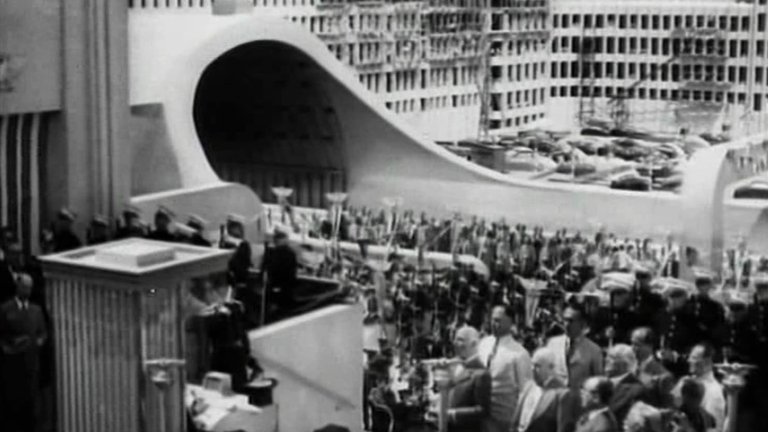Film Review: The Tunnel (Transatlantic Tunnel, 1935)

Two films can be separated by only few years, but, when compared, look like they are separated by decades. One of the early examples can be provided by 1933 Franco-German science fiction film The Tunnel, which was in 1935 remade as eponymous British film directed by Maurice Elvey, also known under title Transatlantic Tunnel.
The film is based on popular 1913 novel by German author Bernhard Kellermann, which was first adapted as 1915 silent film in Germany and in 1933 in two language versions (starring Paul Hartmann and Jean Gabin, respectively). British version has the plot that starts in New York City in relatively near and somewhat unspecified future in mid 20th Century. Richard “Mack” MacAllan (played by George Dix) is brilliant engineer who became famous in 1940 by successfully building Channel Tunnel and later did the same by connecting Miami with Bahamas. He now has the convince group of wealthy and powerful business tycoons to invests billions of dollars into even more ambitious project – undersea tunnel that would connect Britain with United States and, by bringing two mighty English-speaking nations together, guarantee new era of world peace. Project is approved and Mac goes to work, but it takes terrible toll on his family life. Years pass and he is hardly at home and, when public interest dries out, funding is to be secured with Mac reluctantly taking part in PR campaign with Varlia Lloyd (played by Helen Vinson), glamorous daughter of his main financier Lloyd (played by C. Aubrey Smith). This makes his wife Ruth (played by Madge Evans) jealous and, in order to become closer to her husband, she secretly takes job a nurse in the tunnels. She is exposed to tunnel gasses, becomes sick and goes blind. Mac later has to deal with corporate intrigues involving his friend Mostyn (played by Basil Sydney), tunnel project colliding with unknown undersea volcano that might cause horrible delays due to rerouting and, finally, disaster forcing him to make difficult decisions involving his now adult son Geoffrey (played by Jimmy Hanley) who works in the tunnel.
Unlike 1933 film, which still had to deal with growing pains of sound technology, British version looks and sounds like more polished product. It is directed adequately by Maurice Elvey, extremely prolific British director who worked both during silent and sound era and whose experience shows in the film. What ultimately makes 1935 film better than Franco-German version is much more creativity and bigger effort to convincingly portray what was supposed to be near future. Kellermann’s novel was very popular in 1920s and 1930s, because it gave something of an alternative reality in which horrors of Great War never happened. This film could do the same by providing glimpses of the world spared from Second World War. The most noticeable (and, to a degree, correct) prediction about future is widespread use of television and video, technologies that were still in their very early stages in mid 1930s. Production design tries to balance Art Deco with futurism, while Tatra 77, Czehoslovakian motor car known for its streamlined design and advertised as “car of the future”, features prominently in the film. Special effects in the film are quite satisfactory for 1930s standards and do their part in exiting finale.
Those efforts, however, can’t compensate for major problem in the script. The Tunnel is basically story about someone spending years making tunnel under the ocean and it doesn’t have much of a plot. Script tries to compensate that with rather predictable melodrama and love triangles – neglected Ruth is comforted by Mac’s best friend Frederick “Robbie” Robbins (played by Leslie Banks), while Varlia, who loves Mac, is coveted by treacherous Mostyn. There is subplot involving dumping and buying of Tunnel shares that actually goes nowhere. An interesting detail, brought probably more for publicity sake, is appearance of two actors playing British Prime Minister and President of USA, both doing playing similar characters in recent past - George Arliss, who won Oscar for title role in Disraeli and Walter Huston who played title role in Abraham Lincoln (and Gabriel Over the White House). Film praises Anglo-American friendship and alliance that would later be known as “special relationship”, and even mentions their rivals in some sort of “Eastern Federation”, making the future in that particular detail disturbingly similar to our times. But those details aren’t enough to make this film more than curiosity that could be appreciated only by the most hardcore among science fiction cinema fans.
RATING: 5/10 (++)
Blog in Croatian https://draxblog.com
Blog in English https://draxreview.wordpress.com/
Leofinance blog https://leofinance.io/@drax.leo
Unstoppable Domains: https://unstoppabledomains.com/?ref=3fc23fc42c1b417
Hiveonboard: https://hiveonboard.com?ref=drax
Bitcoin Lightning HIVE donations: https://v4v.app/v1/lnurlp/qrcode/drax
Rising Star game: https://www.risingstargame.com?referrer=drax
1Inch: https://1inch.exchange/#/r/0x83823d8CCB74F828148258BB4457642124b1328e
BTC donations: 1EWxiMiP6iiG9rger3NuUSd6HByaxQWafG
ETH donations: 0xB305F144323b99e6f8b1d66f5D7DE78B498C32A7

Yay! 🤗
Your content has been boosted with Ecency Points, by @drax.
Use Ecency daily to boost your growth on platform!
Support Ecency
Vote for new Proposal
Delegate HP and earn more